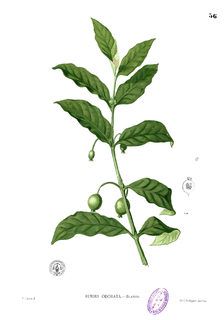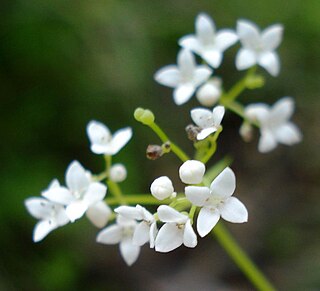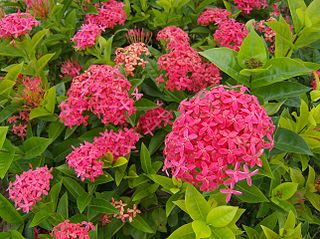
The Rubiaceae are a family of flowering plants, commonly known as the coffee, madder, or bedstraw family. It consists of terrestrial trees, shrubs, lianas, or herbs that are recognizable by simple, opposite leaves with interpetiolar stipules. The family contains about 13,500 species in 611 genera, which makes it the fourth-largest angiosperm family. Rubiaceae has a cosmopolitan distribution; however, the largest species diversity is concentrated in the (sub)tropics. Economically important species include Coffea, the source of coffee, Cinchona, the source of the antimalarial alkaloid quinine, some dye plants, and ornamental cultivars.

Uncaria] of flowering plants in the family Rubiaceae. It has about 40 species. Their distribution is pantropical, with most species native to tropical Asia, three from Africa and the Mediterranean and two from the neotropics. They are known colloquially as gambier, cat's claw or uña de gato. The latter two names are shared with several other plants. The type species for the genus is Uncaria guianensis.

Gentianales is an order of flowering plants, included within the asterid clade of eudicots. It comprises more than 16,000 species in about 1,138 genera in 5 families. More than 80% of the species in this order belong to the Rubiaceae family.

Genipa is a genus of trees in the family Rubiaceae. This genus is native to the American tropical forests.

Galium is a large genus of annual and perennial herbaceous plants in the family Rubiaceae, occurring in the temperate zones of both the Northern and Southern Hemispheres. Some species are informally known as bedstraw.

Morinda is a genus of flowering plants in the madder family, Rubiaceae. The generic name is derived from the Latin words morus "mulberry", from the appearance of the fruits, and indica, meaning "of India".

Psychotria is a genus of flowering plants in the Rubiaceae family. It contains 1,582 species and is therefore one of the largest genera of flowering plants. The genus has a pantropical distribution and members of the genus are small understorey trees in tropical forests. Some species are endangered or facing extinction due to deforestation, especially species of central Africa and the Pacific.

Oldenlandia is a genus of flowering plants in the family Rubiaceae. It is pantropical in distribution and has about 240 species. The type species for the genus is Oldenlandia corymbosa.

Alberta is a monotypic genus of flowering plants in the Rubiaceae family. Most species have been transferred to the genus Razafimandimbisonia, except for the type species Alberta magna. It is native to KwaZulu-Natal, South Africa and is commonly known as Natal flame bush.

Canthium is a genus of flowering plants in the Rubiaceae family. They are shrubs and small trees. The leaves are deciduous and the stems are usually thorny.

Guettarda is a plant genus in the family Rubiaceae. Most of these plants are known by the common name Velvetseed. Estimates of the number of species range from about 50 to 162. Most of the species are neotropical. Twenty are found in New Caledonia and one reaches Australia. A few others are found on islands and in coastal areas of the Indian and Pacific Oceans.

Coffea liberica is a species of flowering plant in the Rubiaceae family from which coffee is produced. It is native to western and central Africa from Liberia to Uganda and Angola, and has become naturalized in the Philippines, Indonesia, Seychelles, the Andaman & Nicobar Islands, French Polynesia, Central America, the West Indies, Venezuela, Colombia, Malaysia and Brazil.

Randia, commonly known as indigoberry, is a mostly neotropical genus of shrubs or small trees in the Rubiaceae. The International Plant Names Index (IPNI) lists a total of 738 names for the genus, synonyms included. Several Australian species have been reassigned to the genus Atractocarpus. These include the garden plants Atractocarpus chartaceus and A. fitzalanii.

Rubieae is a tribe of flowering plants in the Rubiaceae family and contains 969 species in 14 genera. The genus Galium is responsible for more than two thirds of the species in the tribe. The second largest genus is Asperula, which contains about 200 species. Unlike the rest of the Rubiaceae family, the tribe contains predominantly perennial and annual herbs with pseudowhorls of leaves and leaflike stipules and is centered in temperate and tropical-mountain regions.

Vanguerieae is a tribe of flowering plants in the Rubiaceae family and contains about 640 species in 27 genera. It is one of the most species-rich groups within the family and it is distributed all over the Paleotropics.
Retiniphyllum is a genus of flowering plants in the Rubiaceae family and contains 20 species. It is the only genus in the tribe Retiniphylleae. The representatives are shrubs or small trees that grow in white sand soils in tropical South America. They are mainly distributed in the Guayana Region (Venezuela) but also occur in the Amazon Basin, the eastern Andes and central and eastern Brasil.

Plocama is a genus of flowering plants in the family Rubiaceae. It was described by William Aiton in 1789. It is distributed from the Canary Islands to northwestern India.

Ixoroideae is a subfamily of flowering plants in the Rubiaceae family and contains about 4000 species in 27 tribes.
Crossopteryx is a monotypic genus of flowering plants in the Rubiaceae family. The genus contains only one species, viz. Crossopteryx febrifuga, which is found in tropical and southern Africa.


















